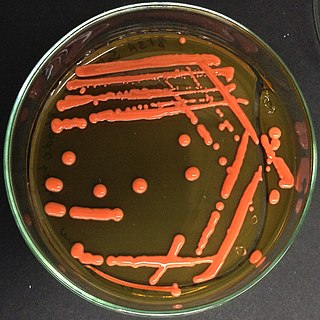
Rhodotorula is a genus of fungi in the class Microbotryomycetes. Most species are known in their yeast states which produce orange to red colonies when grown on Sabouraud's dextrose agar (SDA). The colour is the result of pigments that the yeast creates to block out certain wavelengths of light (620–750 nm) that would otherwise be damaging to the cell. Hyphal states, formerly placed in the genus Rhodosporidium, give rise to teliospores from which laterally septate basidia emerge, producing sessile basidiospores. Species occur worldwide and can be isolated from air, water, soil, and other substrates.
The Agaricostilbomycetes are a class of fungi in the subdivision Pucciniomycotina of the Basidiomycota. The class consists of a single order, six families, and 15 genera. Most species are known only from their yeast states. Where known, basidiocarps (fruitbodies) are typically small and stilboid (pin-shaped).
The Leucosporidiales are an order of fungi in the class Microbotryomycetes. The order contains a single family, the Leucosporidiaceae, which in turn contains a single genus, Leucosporidium. The order comprises fungi that are mostly known from their yeast states, though some produce hyphal states in culture that give rise to teliospores from which auricularioid basidia emerge.

The Sporidiobolales are an order of fungi in the subdivision Pucciniomycotina. The order contains a single family, the Sporidiobolaceae, which currently contains three genera. Most species are known only from their yeast states. Hyphal states produce teliospores from which auricularioid basidia emerge, bearing basidiospores. Species occur worldwide and have been isolated from a wide variety of substrates. Two species, Rhodotorula mucilaginosa and R. glutinis, have been known to cause disease in humans.
The Agaricostilbales are an order of fungi in the class Agaricostilbomycetes. The order consists of six families and 15 genera.
The Agaricostilbaceae are a family of fungi in the order Agaricostilbales. Basidiocarps (fruitbodies}, where known, are stalked and capitate and produce spores on basidia that are laterally septate. Most species are known only from their yeast states. The family contains two genera.
The Chionosphaeraceae are a family of fungi in the order Agaricostilbales. The family contains six genera. Some species form small, stilboid (pin-shaped) fruitbodies. Others are known only from their yeast states.
Colacogloea is a genus of fungi belonging to the class Microbotryomycetes. Most species in the genus are known only from their yeast states. Where known, basidiocarps have auricularioid basidia and occur as parasites on or in the fruit bodies of other fungi.
The Bulleraceae are a family of fungi in the order Tremellales. The family currently contains five genera. Some species produce gelatinous basidiocarps and were formerly placed in the genus Tremella. Most, however, are only known from their yeast states.
Solicoccozyma is a genus of fungi in the family Piskurozymaceae. Species have only been isolated in their yeast states, several of which were formerly referred to the genus Cryptococcus, but can produce filamentous states with basidia in culture. Nine species have been described worldwide.
The Trimorphomycetaceae are a family of fungi in the order Tremellales. The family currently contains four genera. Some species produce filamentous sexual states and are parasites of other fungi. Most, however, are only known from their yeast states.
The Trichosporonaceae are a family of fungi in the order Trichosporonales. The family currently contains six genera. Species are not known to produce basidiocarps, but exist as yeasts or produce septate hyphae with arthroconidia. Several species are human pathogens.
The Tetragoniomycetaceae are a family of fungi in the order Trichosporonales. The family currently contains four genera. Several species are only known from their yeast states.
Ruineniaceae is a family of fungi in the order Agaricostilbales. The family contains a single genus. Species are known only from their yeast states.
The Cystobasidiaceae are a family of fungi in the order Cystobasidiales. The family currently comprises two genera, both of which contain fungal parasites with auricularioid basidia, some of which are known only from their yeast states.
The Cystobasidiales are an order of fungi in the class Cystobasidiomycetes. The order currently consists of a single family (Cystobasidiaceae) and two genera as yet unassigned to a family.
Cystobasidium is a genus of fungi in the order Cystobasidiales. The type species is a fungal parasite forming small gelatinous basidiocarps on various ascomycetous fungi on dung. Microscopically, it has auricularioid basidia producing basidiospores that germinate by budding off yeast cells. Other species are known only from their yeast states. The yeasts Cystobasidium minutum and C. calyptogenae are rare but known human pathogens.
Cystobasidium fimetarium is a species of fungus in the order Cystobasidiales. It is a fungal parasite forming small gelatinous basidiocarps on various ascomycetous fungi on dung. Microscopically, it has auricularioid basidia producing basidiospores that germinate by budding off yeast cells. The species is known from Europe and North America.

The Kriegeriaceae are a family of fungi in the subdivision Pucciniomycotina. The family currently comprises four genera, one of which (Kriegeria) contains a plant pathogenic species with auricularioid basidia. The other genera contain species currently known only from their yeast states.
The Camptobasidiaceae are a family of fungi in the subdivision Pucciniomycotina. The family currently comprises two genera, one of which (Camptobasidium) contains an aquatic, hyphal species with auricularioid basidia. The other genus contains species currently known only from their yeast states.


